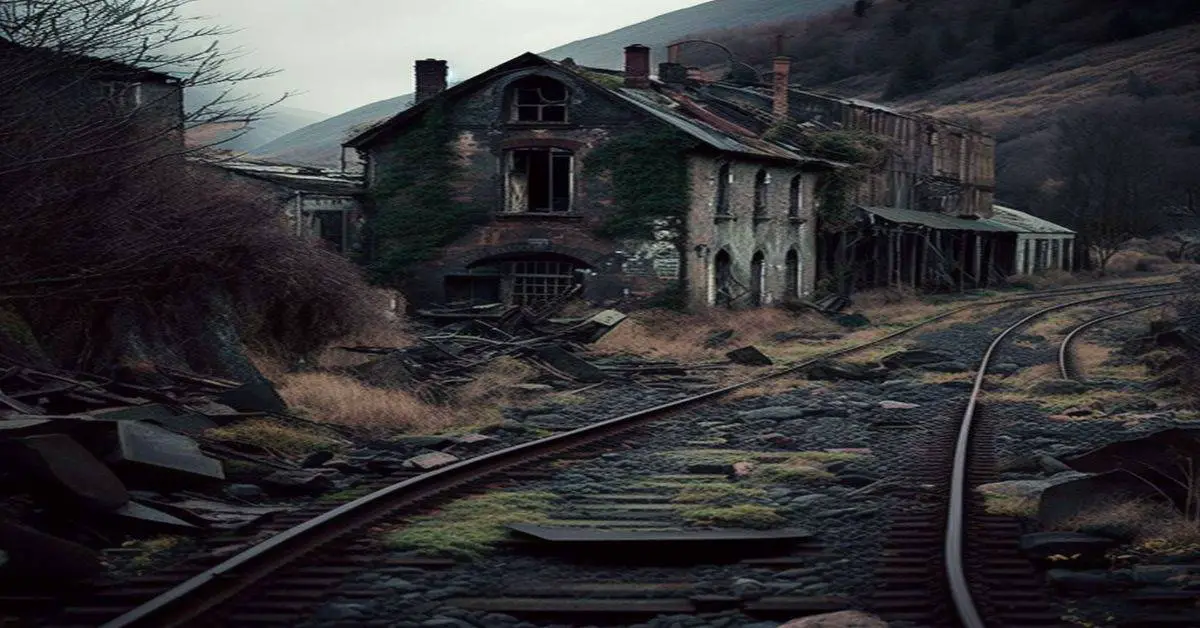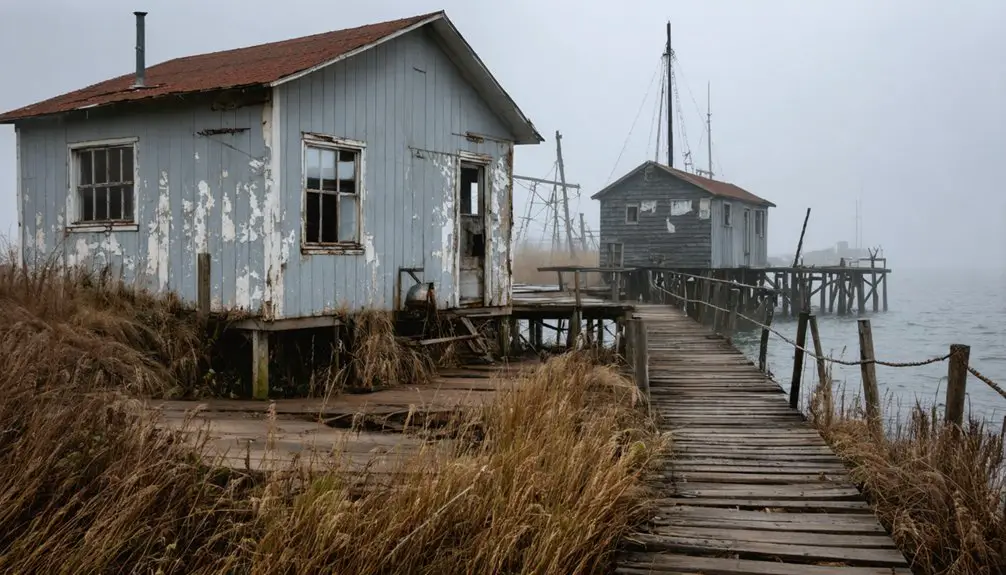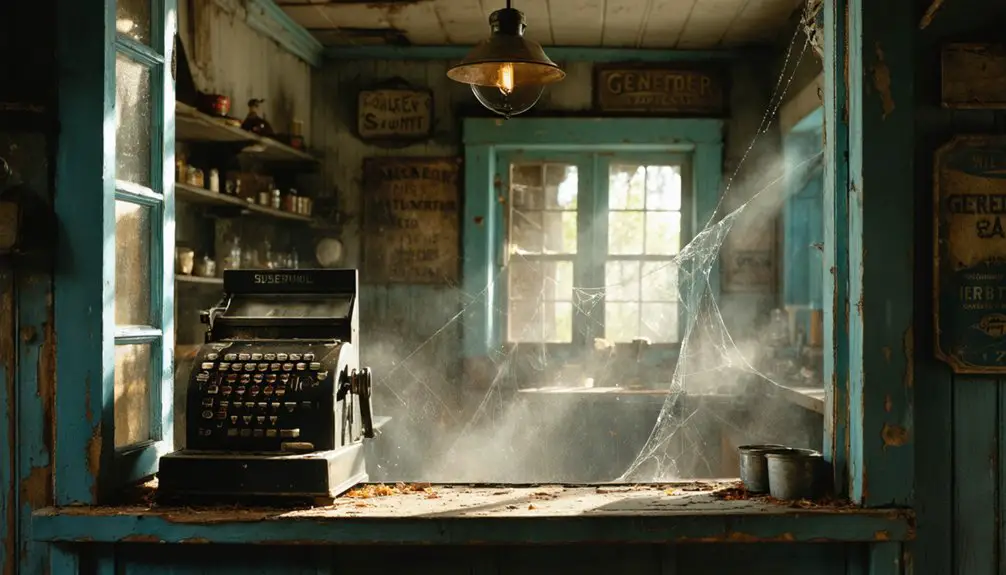You’ll find New Chester’s ghostly remnants in east-central Adams County, Wisconsin, where this once-thriving agricultural settlement began in 1851. The community flourished around virgin pine forests and fertile farmland, with Scandinavian immigrants later transforming it into a dairy farming hub. Though bypassed by crucial rail routes, New Chester’s legacy lives on through its historic cemetery, scattered stonework foundations, and preserved records at the Adams County Historical Society. The site’s untold stories whisper through abandoned dirt roads and weathered grave markers.
Key Takeaways
- New Chester, Wisconsin was established in 1851 and later became a ghost town after being bypassed by crucial rail lines.
- The town’s economy initially thrived on wheat cultivation and later dairy farming before experiencing significant population decline.
- A devastating fire in 1915 destroyed key buildings, contributing to the town’s eventual abandonment.
- Physical remnants include scattered stonework, foundations, abandoned dirt roads, and the historic New Chester Cemetery.
- The Adams County Historical Society maintains extensive records of New Chester, including 2,940 volumes documenting its history.
The Birth of a Prairie Settlement
As surveyors mapped east-central Adams County in 1851, New Chester emerged as a promising settlement on Wisconsin’s frontier landscape.
New frontiers beckoned as surveyors charted New Chester’s destiny in Adams County, marking Wisconsin’s expanding territorial dreams.
You’ll find evidence of ancient Native American settlements here, particularly near Duck Creek where mysterious earthwork fortifications stand as proof to prehistoric military engineering. The land’s strategic position between the Fox and Wisconsin River watersheds made it attractive for early trading routes.
The town’s mixed terrain offered settlers diverse opportunities – from sandy prairie soils in the west to fertile, timbered lands in the east. Amos Landt and others established themselves in the Big Springs area, marking some of the earliest pioneer settlements in the region. The area was officially renamed New Chester in 1861 after previously being known as Chester.
You’ll discover why pioneers like Thomas Rich and William Davis chose this location, forming mutual defense clubs to protect their claims. The limestone deposits, four small lakes, and Neenah Creek headwaters provided natural resources essential for building a new community.
Early Pioneer Life and Community Growth
Building upon the strategic location that first attracted settlers, New Chester’s pioneer community took shape in the early 1860s around its abundant virgin pine forests.
You’d find the earliest homesteads strategically placed near rivers and creeks within the town’s six-mile-square sections, where four small lakes and Neenah Creek provided essential resources.
Despite pioneer challenges like the devastating 1915 fire that destroyed key buildings, the community’s resilience shone through.
Like many Wisconsin communities in 1874, New Chester residents benefited from the Potter Law that helped regulate railroad charges and shipping costs.
The Scandinavian immigrants who arrived after the logging era transformed the economy through dairy farming.
You’ll notice how they established lasting institutions – from the Patrick Farm’s first post office to the neoclassical St. Anne’s Catholic Church built in 1916.
The scattered farmhouses, community halls, and churches formed the backbone of New Chester’s social fabric, even without formal village boundaries.
Agricultural Roots and Economic Foundation
While New Chester’s early settlers initially focused on wheat cultivation, this crop shaped the town’s agricultural foundation throughout the mid-19th century.
You’ll find that wheat farming required minimal startup costs, making it accessible to pioneers establishing their homesteads. By 1849, Wisconsin’s wheat acreage had expanded twentyfold from just a decade earlier. The arrival of immigrant farmers from Germany, Norway, and other European nations brought diverse agricultural knowledge and practices to the region. The area’s rich clay loam soil was particularly well-suited for growing diverse crops.
As soil depletion and pests threatened wheat production after 1870, New Chester’s farmers demonstrated remarkable community resilience by diversifying into crops like hops, tobacco, and hemp.
Agricultural innovations, particularly in dairy farming, transformed the local economy. The introduction of cheese factories and tower silos revolutionized dairy production, while the railroad’s arrival connected farmers to broader markets.
Today, historic farm buildings and structures stand as proof of New Chester’s rich agricultural heritage.
Daily Life in 19th Century New Chester
Life in New Chester revolved around both hard work and vibrant social gatherings, with your typical day split between tending to crops or livestock and participating in community events at the local halls and churches.
You’d find yourself attending frequent schoolhouse socials where families gathered for performances, spelling bees, and holiday celebrations that brought together the town’s diverse ethnic groups.
During harvest seasons, you’d join your neighbors in collective farm work, followed by festive gatherings that often included shared meals at community halls or one of the town’s three well-kept hotels. The growing dairy farming industry became central to the town’s economy after wheat farming declined due to soil exhaustion in the Civil War era.
Community Gatherings and Festivals
During the nineteenth century, New Chester’s social fabric was woven through vibrant community gatherings and festivals that punctuated the rhythms of daily life.
You’d find social cohesion at its strongest during Sunday church services, which served as the week’s primary gathering point in multi-use buildings or private homes. Festival traditions evolved through harvest celebrations, spring planting events, and seasonal fairs where you could trade goods and share labor.
Local entertainment centered around barn raisings, quilting bees, and evening gatherings filled with card games and fiddle music. Like many early Wisconsin settlements, the town’s diverse character was shaped by European immigrants who established the community. Similar to how ghost towns preserve historical structures today, these social traditions helped maintain the community’s cultural heritage.
The one-room schoolhouse doubled as a civic center, hosting debates and town meetings. When traveling circuses or entertainers passed through, they’d bring rare variety to the community’s leisure activities.
Immigrant groups enriched these gatherings by incorporating their cultural traditions, dances, and foods.
Farm Work and Routines
Beyond the communal festivities that marked special occasions, the harsh realities of daily farm work shaped New Chester’s nineteenth-century existence.
You’d find yourself working from sunrise to sunset, clearing roughly 80 acres of timberland over your lifetime through the backbreaking process of girdling trees and removing stubborn stumps. Without crop rotation, your wheat fields would quickly exhaust the soil, while livestock management meant dawn-to-dusk responsibilities of feeding and milking.
Your tools were basic – hand drills for sowing, scythes for harvesting – while oxen provided the only powered assistance. The introduction of John Deere’s plow in the mid-1800s made soil cultivation more efficient for those farmers who could afford the new technology. To learn more about specific farming implements, settlers could access library resources through appointment-based services at nearby institutions.
You’d plan your year around nature’s rhythm: spring planting, summer maintenance, fall harvest, and winter repairs, all while gathering firewood and mending fences between major tasks.
Schoolhouse Social Activities
The humble schoolhouse stood as New Chester’s vibrant social hub, serving far beyond its educational mission.
You’d find community dances filling the wooden floors with lively steps, while literary societies gathered to sharpen minds through spirited debates and spelling competitions.
After the harvest season, you could join your neighbors for holiday celebrations, public meetings, or religious gatherings when church buildings weren’t available.
Children played central roles in these social functions, performing plays and recitations that brought the community together.
You’d see parents and town residents volunteering their time, organizing fundraisers, and maintaining the grounds.
These gatherings helped combat the isolation of rural life, especially among scattered farmsteads, while strengthening the bonds between immigrant families through shared local traditions.
The Impact of Transportation Routes
Transportation routes played a decisive role in shaping New Chester’s destiny, as they did for numerous Wisconsin settlements during the 19th century. The transportation significance of rail line placement often meant the difference between a town’s survival or its fade into obscurity.
Rail line placement could make or break a 19th-century Wisconsin settlement, determining whether it thrived or vanished into history.
When you examine New Chester’s economic implications, you’ll find a pattern similar to other Wisconsin communities that struggled without reliable transport connections.
- Rail routes bypassing the settlement limited access to vital markets for local agricultural products.
- Lack of efficient transportation infrastructure discouraged new businesses from establishing themselves.
- The town’s isolation from major transport arteries accelerated population decline as younger residents sought opportunities in better-connected communities.
These transportation challenges ultimately contributed to New Chester joining the ranks of Wisconsin’s ghost towns.
Decline of Family Farming Era

While transportation challenges contributed to New Chester’s decline, a broader agricultural transformation swept through Wisconsin’s farming communities, fundamentally altering their economic foundation.
You’ll find that family succession became increasingly difficult as farming challenges mounted, with Wisconsin losing over 18,600 farms between 2002 and 2022.
Dairy operations were hit particularly hard – you’d have seen a staggering 63% decrease in dairy farms during this period. The economic pressures proved overwhelming for many families, who couldn’t generate enough income to maintain their operations.
Without young farmers stepping in to take over aging operations, and faced with rising costs of labor and technology, many local families had to supplement their income with off-farm jobs.
Eventually, small family farms gave way to larger, consolidated operations.
Remnants and Ruins Today
You’ll find scattered stonework and foundations throughout New Chester’s grounds, with the most notable remaining structure being the former Union telephone company building, identifiable by its distinctive metal mesh windows.
Walking the site’s abandoned dirt roads reveals how nature has largely reclaimed the landscape, though some historic markers still indicate where stagecoach stops and inns once stood.
While the area’s gravesites aren’t extensively documented, the ruins paint a clear picture of a once-thriving rural community that served as an important transportation and communication hub in 19th-century Adams County.
Cemetery and Gravestone Locations
Located on the east side of County G and south of County E, the New Chester Cemetery stands as one of the most significant remnants of this Wisconsin ghost town.
You’ll find this historic burial ground behind a church that’s visible from the county road, where generations of early settlers rest beneath weathered markers that tell their stories through gravestone inscriptions.
For history enthusiasts and genealogy researchers, here’s what you’ll discover:
- Original burial traditions preserved through various gravestone styles and layouts typical of 19th-century rural Wisconsin
- Family lineages and cultural heritage documented in stone, though some inscriptions have faded with time
- A rare window into New Chester’s past, with markers of prominent township figures still standing despite years of exposure
Remaining Building Structures
Throughout New Chester’s remaining landscape, visitors can observe scattered structural remnants that offer glimpses into the town’s bygone era.
You’ll find abandoned structures dating to the late 1800s, including stone-built blacksmith shops and partially standing commercial buildings that showcase period architectural styles. While most buildings exist as partial ruins, several stone and brick structures have endured, though they’re missing roofs, windows, and doors.
You can explore the foundations of former agricultural and industrial sites, where old barn ruins and mill remnants tell stories of the area’s economic past.
A few public buildings, such as former churches and schools, remain as more substantial ruins. These weathered structures, along with visible stone foundations emerging from overgrown terrain, serve as silent witnesses to New Chester’s once-thriving community.
Abandoned Roads and Paths
The abandoned road network of New Chester reveals a ghostly grid pattern of early 20th-century thoroughfares, now largely reclaimed by nature.
You’ll find gravel and dirt surfaces peeking through thick vegetation, while forgotten pathways lead to dead-end residential lanes that once bustled with activity.
Nature’s reclamation is evident in the moss-covered stone curbs and deteriorating bridge foundations that span minor creeks.
- Explore narrow dirt footpaths through wooded areas that trace routes between former homes, mills, and water sources.
- Discover remnants of cobblestone sections near old commercial areas, marked by scattered artifacts and boundary walls.
- Notice how seasonal flooding and tree roots have permanently altered road alignments, while native plants steadily consume what remains of these historic transit corridors.
Cultural Heritage and Local Stories
Like many Wisconsin ghost towns shaped by European immigration, New Chester developed a rich cultural tapestry woven from its diverse settler population in the mid-19th century.
You’ll find traces of Cornish architectural influences and farming traditions that settlers brought with them, creating a unique community identity that persisted through generations.
Local folklore narratives paint vivid pictures of life in New Chester, with tales of harsh winters, economic challenges, and the daily rhythms of rural commerce.
The town’s cultural preservation efforts now rest largely in oral histories passed down through families and historical societies.
While the physical structures have largely disappeared, you can still discover stories of general stores, post offices, and community gatherings that once defined this settlement’s vibrant social life before its decline into a ghost town.
Legacy in Wisconsin’s Rural History
Standing as a poignant example of rural transformation in Wisconsin, New Chester’s story mirrors hundreds of similar communities that once dotted the state’s landscape during the 19th and early 20th centuries.
You’ll find its ghost town narratives woven into the broader tapestry of America’s shifting rural dynamics, where agricultural consolidation and transportation changes reshaped local economies.
- New Chester exemplifies how European immigrant settlements transformed from vibrant farming communities into abandoned townscapes.
- The town’s decline highlights critical challenges in rural sustainability as smaller farms gave way to large agricultural operations.
- You can trace the impact of infrastructure decisions, particularly railroad routing, that determined whether communities thrived or failed.
This once-bustling settlement now serves as a reflection of the delicate balance between economic progress and community preservation in Wisconsin’s heartland.
Preservation Efforts and Historical Records
Today’s preservation efforts for New Chester center on documentation within Wisconsin Historical Society archives and local historical records, including cemetery plot maps and land ownership records.
You’ll find the most thorough information about New Chester through Adams County Historical Society‘s archival collections, which maintain both physical and digitized records of the ghost town’s brief existence.
While New Chester hasn’t received official landmark status, local historians continue to catalog remaining grave markers and foundation remnants to preserve the settlement’s place in Wisconsin’s rural development history.
Cemetery Documentation Projects
The preservation of New Chester’s historic cemetery relies on four key documentation initiatives that protect its cultural heritage.
Through detailed cemetery mapping efforts and community involvement, you’ll find extensive data collection that serves both historical research and future preservation planning. Local volunteers work alongside preservation experts to create detailed digital records of grave markers, boundaries, and cemetery conditions.
- Digital documentation using GIS technology helps track and protect each burial site while creating accessible records for genealogical research.
- Regular photographic surveys capture the condition of monuments and inscriptions, supporting grant applications for preservation funding.
- Community-led transcription projects preserve essential historical information while fostering local stewardship of this important cultural landmark.
Historical Society Archives
Rich historical treasures await researchers at New Chester’s Historical Society Archives, where preservation efforts protect over 2,940 volumes and 1,823 cubic feet of original records.
You’ll find extensive manuscripts and personal papers that document the area’s early American West history, housed in a fireproof facility with specialized preservation equipment.
The archives’ integration with records management guarantees you’ve got access to both historical documentation and modern research tools.
You can explore deed books dating to 1918, early maps, and various other materials essential for genealogy and property research.
Digital guides make navigation simpler, while expert staff are ready to assist with your inquiries.
The society’s commitment to preservation techniques means these invaluable records will remain accessible for future generations.
Local Landmark Status
While historical society archives preserve New Chester’s documented past, current landmark preservation efforts remain considerably sparse for this Adams County ghost town.
You’ll find minimal local recognition for this abandoned site, with no active preservation initiatives or protected status designations from municipal or county authorities. The challenges of maintaining New Chester’s historical legacy are evident in its current state.
- No official landmark status exists in state or local preservation registers
- The site lacks organized restoration projects or dedicated preservation funding
- Limited physical remnants remain, with no documented management plans for site protection
The absence of community engagement and government advocacy has left New Chester’s historical significance largely unprotected, reflecting broader preservation challenges faced by Wisconsin’s lesser-known ghost towns.
Frequently Asked Questions
Were There Any Notable Crimes or Mysterious Incidents in New Chester’s History?
Unlike 70% of Wisconsin ghost towns that have dark histories, you won’t find any documented unsolved mysteries or ghost sightings here – historical records show no notable crimes in this former mining community.
What Native American Tribes Originally Inhabited the New Chester Area?
You’ll find rich Native Tribes’ cultural heritage in this region, where the Ho-Chunk (Winnebago), Menominee, Potawatomi, and Ojibwe peoples originally lived, hunted, and maintained spiritual connections to the land.
Did Any Famous People or Historical Figures Ever Visit New Chester?
Despite a peak population of 864 residents, you won’t find any documented famous visitors or historical figures who stopped in the town – no politicians, celebrities, or notable personalities ever visited.
What Was the Highest Recorded Population of New Chester?
You’ll find the highest recorded population growth reached 2,254 in 2010, though historical records specifically for the ghost town’s peak aren’t documented. Earlier settlement numbers remain uncertain in available data.
Were There Any Major Natural Disasters That Affected New Chester?
Despite Wisconsin’s history of severe weather, there’s no evidence of major natural disasters directly impacting New Chester. You won’t find records of significant flood damage or tornado impact affecting the town’s decline.
References
- https://lakecountrytribune.com/exploring-the-haunting-echoes-of-wisconsins-ghost-towns/
- https://pbswisconsin.org/news-item/southern-wisconsins-ghost-towns-leave-behind-vital-stories/
- https://www.geotab.com/ghost-towns/
- https://www.youtube.com/watch?v=hyvSTpgwddA
- https://en.wikipedia.org/wiki/List_of_ghost_towns_in_Wisconsin
- https://www.formycousins.com/1878/1878atlas-Adams.html
- https://winneshiekcounty.iowa.gov/wp-content/uploads/2019/09/96-012-An-Intensive-Historical-Site-Survey-of-the-Washington-Prairie-Settlement.pdf
- https://newchester.gov/wp-content/uploads/2021/03/T.-New-Chester-2016-Comprehensive-Plan.pdf
- http://genealogytrails.com/wis/adams/history.html
- https://townofstarprairiewi.gov/town-history/



